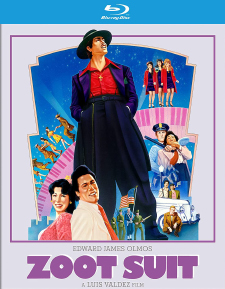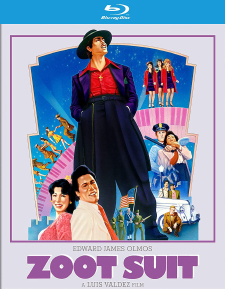Zoot Suit (Blu-ray Review)

Director
Luis ValdezRelease Date(s)
1981 (March 15, 2021)Studio(s)
Universal Pictures (Kino Lorber Studio Classics)- Film/Program Grade: C
- Video Grade: A-
- Audio Grade: A
- Extras Grade: A-
Review
Zoot Suit, based on actual events, deals with a gang murder in Los Angeles in the early 1940s. Director Luis Valdez adapted his own stage play and often breaks the fourth wall for a particular character to address the audience or to show an audience watching the action. The film is an odd melange of crime drama, musical, sociopolitical critique, and mythologizing treatise on the Chicano spirit.
Popularized by jazz musicians in the 1930s, the “zoot suit” style of menswear required an enormous amount of fabric. The pants featured exaggeratedly ballooning legs, a high waist, and tight cuffs. The jacket had heavily padded shoulders and hung down to the knees. The outfit was not complete without a watch chain that looped down below the knees. The style originated in Harlem and was adopted by Mexican-Americans in Los Angeles shortly thereafter.
In 1942, a young Latino was stabbed to death after being confronted by a group of friends about an earlier altercation. The L.A. police arrested 17 Mexican-American boys who were held in jail without bail, eventually convicted of second-degree murder despite insubstantial evidence, and sentenced to serve many years in prison.
Telling this story in straightforward fashion would have made a gripping drama. Instead, Valdez eschews traditional narrative in favor of stylization. Mixing in rhythmic songs, lively dances choreographed by Patricia Birch, and distracting stage techniques, he creates a choppy amalgamation of film and live theater. Actors huddle in small groups as backgrounds are darkened and stage lighting illuminates specific parts of the frame. Sometimes the action spills out into a packed audience.
With a cast made up almost entirely of Valdez’s theater company, the film projects a driving energy which is infectious. Interspersing the tale of Henry Reyna (Daniel Valdez, the director’s brother), leader of the accused Chicanos who is plagued by a menacing alter-ego (Edward James Olmos), with vibrant musical numbers gives the picture an air of celebration, which seems contradictory in a story about racial injustice. It’s often jarring when Valdez switches from a serious scene to a musical interlude. The technique enlivens the picture, but at a cost. These scenes may be viewed more as celebration than an emotional outlet for a marginalized minority.
Tyne Daly co-stars as sympathetic Alice Bloomfield, John Anderson plays biased judge F.W. Charles, and Charles Aidman portrays good-hearted attorney George Shearer fighting the racially motivated, unjust conviction. The most memorable performance is that of Olmos as the surrealistic El Pachuco, a mysterious figure who lurks through the film as both a spiritual icon of the Chicano people and Henry’s alter-ego. Dressed in a red shirt and black zoot suit, he slinks through scenes, strikes poses, sneers, and delivers poisonous comments. His is the most stylized character.
Because director Valdez has chosen a hybrid theatrical-cinematic format, he often distances the viewer. The result is an overly ambitious hodgepodge. The production design and cinematography, with their blaze of color, movement, and vivid lighting, give the film the look of an extravagant pageant.
Zoot Suit was shot by director of photography Daniel Myers on 35 mm film with spherical lenses, finished photochemically, and presented in the widescreen aspect ratio of 1.85:1. Apart from small specks visible in dark scenes, the picture quality is sharp with excellent detail in the 1940s-style costumes. The color palette varies from bright, primary hues in the musical numbers to darker, more subdued tones when the film turns its attention on Henry Reyna’s plight. Skin tones are natural. Reds dominate throughout, from El Pachuco’s shirt and lapel tulip to the deeply saturated red lipstick and heavily applied rouge of the women. Hairstyles are accurate for the period. Theatrical devices employed include blending scenes into one another, actors’ asides to the audience, directed lighting to focus attention, and revolving sets.
The soundtrack is English 2.0 DTS-HD Master Audio with optional English subtitles. Dialogue is clear and precise, though Edward James Olmos tends to deliver his lines softly. The musical numbers sound great, with Daniel Valdez’ original music enhancing the film with an uplifting energy. Many of the songs have Spanish lyrics. Selected songs of the 1940s, such as American Patrol, St. Louis Blues, Green Eyes, and Two O’Clock Jump, add to the film’s period flavor. In a number called Handball, actors pantomime hitting a ball into the wall as sound effects complete the illusion.
Bonus materials on the Region A Blu-ray release from Kino Lorber Studio Classics include the following:
- Audio Commentary by Daniel Kremer
- Interview with Luis Valdez (15:47)
- Trailer (2:17)
- The Milagro Beanfield War Trailer (1:23)
- Get Crazy Trailer (1:32)
Filmmaker and film historian Daniel Kremer refers to Zoot Suit as “an innovative piece of cinema.” The film was entered into the Library of Congress’ National Film Registry in 2019. It’s a film, theater, true-crime story, historical interpretation, miscarriage of justice, cultural and mythological exploration, musical, and Brechtian pageant. The contribution of Luis Valdez to Chicano theater is detailed extensively. Valdez has written plays, books, poems, and has made films, among them La Bamba. Valdez regards the on-screen audience as part of the community. Zoot Suit was shot at the Mark Taper Forum in Los Angeles. Other films that appear to be theatrical are mentioned. During World War II, loud, ostentatious zoot suits were looked upon as disrespectful of men in uniform at a time of austerity and sacrifice. The El Pachuco character represents both an “other self” and a Chicano angel looking out over his “flock.” The film did not do well at the box office and a number of critics felt the stage/film hybrid structure was confusing.
In the interview with writer and director Luis Valdez, he mentions that the zoot suit was originally designed to allow for smooth movement. It gained popularity first in Harlem and then in Los Angeles, “where it came home to roost.” Mexican-American kids picked up on the fashion fad because of the counter-culture of the period and the end of the Depression just before World War II. Valdez outlines the 1942 Chicano gang fight outside of Los Angeles in a lover’s lane area known as Sleepy Lagoon that forms the basis of Zoot Suit. It was a tense time. Shortly before this event, Japanese-Americans in California were rounded up and sent to relocation camps. The boom in factory weapon making for the war led to rivalry for jobs among different ethnic groups. In 1943, the zoot suit riots erupted on the streets of L.A. The Reyna character in the film is based on Henry “Hank” Leyvas, a gang leader who was singled out for the murder. Edward James Olmos and Daniel Valdez provide a portrait of Leyvas. The 1978 play broke the record for top grossing, longest-running play in Los Angeles. Valdez was inspired by Hollywood musicals of the 1940s. The film is a time capsule presenting its own reality and speaks to the urban experience as a whole.
The Blu-ray cover features the original poster art on one side and newly commissioned art—a large image of El Pachuco surrounded by various scenes from the film—on the other. The slipcover features the original poster art as well.
It was unusual in the early 80s to have a film from a major Hollywood studio starring an almost 100% Latino cast. Though set in 1940s Los Angeles, Zoot Suit feels timely with its themes of racial bias, systematic oppression, and identity. Though the structure might put off viewers, the film succeeds in making an important statement.
- Dennis Seuling

